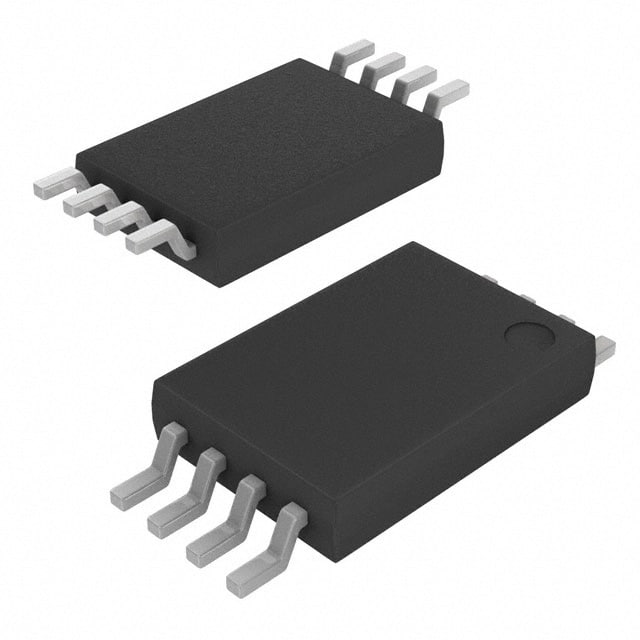Lihat spesifikasi untuk detail produk.

24LC16B-I/STG
Product Overview
Category
The 24LC16B-I/STG belongs to the category of electrically erasable programmable read-only memory (EEPROM) chips.
Use
This product is commonly used for non-volatile data storage in various electronic devices, such as microcontrollers, computers, and consumer electronics.
Characteristics
- Non-volatile: The stored data remains even when power is removed.
- Electrically erasable: Data can be erased and reprogrammed electronically.
- Low power consumption: Operates on low voltage and consumes minimal power.
- High endurance: Can withstand a large number of write and erase cycles.
- Small form factor: Compact size allows for integration into space-constrained designs.
Package
The 24LC16B-I/STG is available in a small outline transistor (SOT) package, which ensures easy integration into circuit boards.
Essence
The essence of this product lies in its ability to provide reliable and non-volatile data storage in electronic devices, enabling them to retain important information even when powered off.
Packaging/Quantity
The 24LC16B-I/STG is typically packaged in reels or tubes, with each reel containing a specific quantity of chips. The exact packaging and quantity may vary depending on the manufacturer's specifications.
Specifications
- Memory capacity: 16 kilobits (2 kilobytes)
- Operating voltage: 1.7V to 5.5V
- Operating temperature range: -40°C to +85°C
- Write endurance: Up to 1 million write cycles
- Data retention: Up to 200 years
- Interface: I2C (Inter-Integrated Circuit)
Detailed Pin Configuration
The 24LC16B-I/STG has a total of 8 pins, each serving a specific purpose:
- VCC: Power supply voltage input
- SDA: Serial data line for I2C communication
- SCL: Serial clock line for I2C communication
- WP: Write protect pin for hardware protection
- A0: Address bit 0 for device addressing
- A1: Address bit 1 for device addressing
- A2: Address bit 2 for device addressing
- GND: Ground reference
Functional Features
- Random access: Allows reading and writing of specific memory locations.
- Byte-level operations: Supports individual byte read and write operations.
- Page write mode: Enables faster writes by allowing multiple bytes to be written in a single operation.
- Software write protection: Provides the option to protect specific memory areas from accidental modification.
- Sequential read mode: Facilitates efficient retrieval of consecutive memory locations.
Advantages and Disadvantages
Advantages
- Non-volatile storage: Ensures data integrity even during power loss.
- High endurance: Can withstand frequent write and erase cycles.
- Compact size: Suitable for space-constrained designs.
- Low power consumption: Helps prolong battery life in portable devices.
- Easy integration: Available in a standard package with industry-standard interface.
Disadvantages
- Limited storage capacity: The 24LC16B-I/STG offers 16 kilobits of memory, which may not be sufficient for certain applications requiring larger storage.
- Relatively slower write speed: Compared to other memory technologies, EEPROMs generally have slower write speeds.
Working Principles
The 24LC16B-I/STG utilizes electrically controlled floating gate transistors to store and retrieve data. When writing data, an electrical charge is applied to the floating gate, altering its conductivity and storing the desired information. During read operations, the stored charge is measured, allowing the retrieval of the stored data.
Detailed Application Field Plans
The 24LC16B-I/STG finds applications in various fields, including:
- Embedded systems: Used for storing configuration data, firmware updates, and user settings in microcontrollers.
- Automotive electronics: Employed for storing critical information like mileage, vehicle identification numbers (VIN), and calibration data.
- Industrial automation: Utilized for storing parameters, calibration data, and event logs in programmable logic controllers (PLCs).
- Consumer electronics: Integrated into devices such as smart TVs, set-top boxes, and gaming consoles to store user preferences and settings.
Detailed and Complete Alternative Models
- 24LC32A-I/P: A higher capacity EEPROM chip with 32 kilobits of memory.
- 24LC64-I/SN: Offers double the capacity of the 24LC16B-I/STG, with 64 kilobits of memory.
- 24LC256-I/P: Provides a significantly larger storage capacity of 256 kilobits.
These alternative models offer increased memory capacity, catering to applications that require more extensive data
Sebutkan 10 pertanyaan dan jawaban umum terkait penerapan 24LC16B-I/STG dalam solusi teknis
What is the maximum clock frequency for 24LC16B-I/STG?
- The maximum clock frequency for 24LC16B-I/STG is 400 kHz.What is the operating voltage range for 24LC16B-I/STG?
- The operating voltage range for 24LC16B-I/STG is 1.7V to 5.5V.Can 24LC16B-I/STG be used in automotive applications?
- Yes, 24LC16B-I/STG is suitable for automotive applications.What is the typical write cycle time for 24LC16B-I/STG?
- The typical write cycle time for 24LC16B-I/STG is 5 ms.Is 24LC16B-I/STG compatible with I2C protocol?
- Yes, 24LC16B-I/STG is compatible with I2C protocol.What is the maximum write endurance for 24LC16B-I/STG?
- The maximum write endurance for 24LC16B-I/STG is 1,000,000 cycles.Can 24LC16B-I/STG operate at extended temperature ranges?
- Yes, 24LC16B-I/STG can operate at extended temperature ranges from -40°C to 125°C.What is the package type for 24LC16B-I/STG?
- 24LC16B-I/STG is available in a 8-lead SOIC package.Does 24LC16B-I/STG have built-in write protection?
- Yes, 24LC16B-I/STG features built-in hardware write protection.Is 24LC16B-I/STG RoHS compliant?
- Yes, 24LC16B-I/STG is RoHS compliant.

